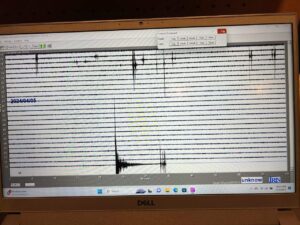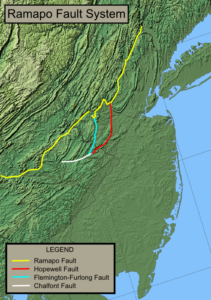What caused the April 5th earthquake?
Friday, April 5th, 10:23 in the morning. I’m a late riser, so I’m just waking up, but still in bed and half asleep. Suddenly I hear a rattling. My dog jumps to his feet and starts pacing nervously, and I am wide awake. The bed sways under me, and there is a moment of confusion and dread. Then it stops. Although I have never experienced one before, I’m instantly sure I just felt an earthquake. I immediately called my dad who lives about a mile away to make sure it wasn’t just a truck driving by or my house settling. The instant he answers he asks, “Did you feel that shaking a minute ago?”
On April 5th, a 4.8 magnitude earthquake with an epicenter near Lebanon, NJ, occurred.
This happened despite the relative rarity of such seismic events in the Northeast. It became national news in part because of its close proximity to New York City, which is about as far away from Lebanon, NJ, to the east, as the Lehigh Valley is to the west. It rattled the nerves of most but didn’t appear to cause any damage. Even to people in the affected area originally from the west coast, who are used to such behavior from the temperamental geology along the Pacific coast, it was noteworthy.
Seismograph from NNC’s seismometer of the April earthquake
I have written two blogs about earthquakes, seismology, and our seismograph that go over the basic causes of these natural disasters and how they are detected, and I encourage you to go back and read them: When the Earth Moves and When the Earth Moves Again. For this post let’s just focus on this specific earthquake and address some ideas that were circulating about the cause of this particular temblor.
It is natural for people to look for reasons why something as rare and significant as an earthquake might occur. Humans are great at pattern seeking but sometimes we see patterns and causes where there are none. Science is a powerful tool for finding patterns and equally good at rejecting false patterns. In the days after the earthquake I heard a lot of ideas about why it occurred when it did. Let’s review a few of them here.
Idea #1 – The eclipse caused it
Some people suggested that the great 2024 eclipse was the cause of the earthquake. To put it mildly, this is not correct. First, the eclipse had not yet occurred at the time of the earthquake and was still 3 days away. More importantly there is no known way for an eclipse to cause an earthquake. Let’s consider the effects that an eclipse has on earth. The most obvious is the shadow of the moon cast on the earth. This makes some regions experience the total absence of the sun for a few minutes while a far larger area experiences a partial blocking of the sun by the moon. How could a shadow cause the earth’s crust to move? A shadow is no more likely to do that than a large cloud or even the coming of night. The other effect that the moon has on the earth is its gravitational pull. Here we at least have a plausible mechanism. The moon’s gravitational pull is weak but acts over a large area and we know it can bring in the tides. Despite the moon’s undeniable effect on the oceans, the crust of the earth is much harder to influence by the force of the moon. If the moon did cause earthquakes, why wouldn’t they happen every day just like the tides? The moon’s gravitational pull during an eclipse is not any stronger than at any other time that the moon is in the sky. It’s true that when the moon and the sun are near each other they work together to produce a more pronounced tide called a king tide but this happens every month during the new moon not just during an eclipse and there is no connection between king tides and earthquakes either.
Idea #2 – Heavy rain
In the days before the earthquake the region experienced record breaking rainfall totals. We experienced a normal month’s worth of rain in the first few days of April. Some people suggested that this could be why the earthquake occurred. Research has suggested that groundwater can lubricate a fault and help trigger an earthquake. Sudden changes in groundwater levels are even more likely to release energy in a fault so we have a mechanism that seems plausible at first pass. That is until we consider the origin point of the earthquake. The epicenter was in central New Jersey but not at the surface. It originated from a point 2.9 miles below the surface. The rate that water seeps in the ground is extremely variable but it is generally a very slow process. Water moves through soils at a rate of about 10 feet per year! That means today’s rain might take a decade or more to reach a depth of just a hundred feet where we might find the water table. The heavy rain from April 5th might never reach the rock layers 2.9 miles below the surface and if it does it won’t be for many centuries. By the time it reaches that depth it will be attenuated and smeared out as it gradually drip, drip, drips into the depths of the earth. There is no way for rain that fell a few days ago to seep into the earth and affect the rock layers in question.
Idea #3 – Round Valley Reservoir
This was another idea I personally heard in the days after the earthquake. Round Valley Reservoir is a man-made body of water. It was first filled in the 1960s and is now over 180 feet deep in some places and contains over 55 billion gallons of water making it the largest reservoir in the state of New Jersey. We just discussed why water itself is unlikely to be a cause (at least for the next couple hundred years). But what about the weight of that water itself? There is evidence that large reservoirs can exert enough pressure to trigger earthquakes. It’s called reservoir-induced seismicity. There are hundreds of examples of increases in earthquake activity near large reservoirs. The only issue here is scale. Round Valley Reservoir is much smaller than the kinds of reservoirs that have been blamed for causing earthquakes in the past. For example Koyna dam in India might have caused a magnitude 6.7 earthquake. Koyna dam has a surface area of 220,000 acres. Round Valley has a surface area of 2,300 acres. Literally 2 orders of magnitude smaller. Even in the case of the massive Koyna dam we can not prove it was the cause.
Idea #4 – Climate change
This is one I heard on the TV from a news anchor speculating about the cause minutes after it occurred. Climate change actually could be part of the cause of this earthquake but not in the way you might expect. Climate change’s most pronounced effect is the gradual warming of the surface of the earth caused by trapping heat by excess greenhouse gasses in the atmosphere like CO2. This increased surface temperature does not seem like an obvious way to cause an earthquake, but it also results in changes in the location and thickness of ice sheets and glaciers. Research suggests that the melting of large, thick ice sheets results in a prolonged period of extra water entering the water table which can eventually reach rock layers and lubricate them enough to trigger an earthquake, though as we have already seen this is a slow gradual process. Another factor is rebound. When a larger ice sheet or glacier melts away, the area under it is relieved of all the weight and pressure of that body of ice. This is the reverse of reservoir-induced seismicity. When you get up from a nice comfy chair the foam rebounds for a few seconds. This is a good analogy except the land takes hundreds or even thousands of years to rebound and this can also trigger earthquakes. Our area has no glaciers but it did have them 20,000 years ago during the last glacial maximum. The climate changes that ended the ice age have nothing to do with human activity. The climate changed gradually back then and we lost our glaciers but the land is still rebounding. Although it is impossible to say for certain that this earthquake happened because of the melting of glaciers from the ice age, it could be a warning for the long term consequences of the warming we are causing today.
What if there is no definitive cause?
Earthquakes can be triggered by human activities. The most clear example comes from hydraulic fracturing. Hydraulic fracturing is a process used in the oil and gas industry to make rock layers deep underground more porous by literally fracturing them by pumping fluid into the ground under extreme pressure. This process can lubricate existing faults which can trigger seismic events and even spur earthquakes in places that had no history of seismic activity previously. This does not mean all earthquakes have a human cause or even a definitive natural cause.
More than likely the earthquake that occurred on April 5th was caused by the formation and breakup of Pangea – events that happened over 300 million years ago and that are completely out of our control. This is not to say that we should just throw up our hands in the face of uncertainty. A few months before the earthquake I wrote an article warning about the potential of an earthquake on the Ramapo fault, the very fault that the April 5th earthquake occurred along. We have the ability to assess the risk of faults. We can’t predict exactly when they will trigger earthquakes but we know where many of them are and how likely they are to produce earthquakes of a given size and we get better at making these predictions every day. We leave it to future generations of scientists to improve our ability to predict this and other natural disasters with ever more accuracy and specificity.




